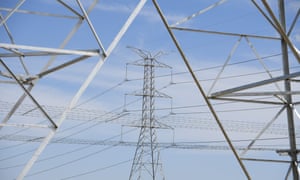Lower wholesale prices will give typical household a saving of $55 a
year in next two years, Australian Energy Market Commission says
Increased wind and solar generation will help drive power prices down
by 2.1% on average in the next two years, according to the Australian Energy Market Commission.
The electricity price trend report, released on Friday, reveals that consumers in South Australia can expect the biggest price falls – down $120 a year on average by 2021 – followed by south-east Queensland ($76), Tasmania ($39), New South Wales ($27) and Victoria ($25).
But prices will soar 9.3% in Western Australia, or $156 a year, with rises also expected in the Australian Capital Territory, up $87, and the Northern Territory, up $47.
The release of the report follows the energy ministers’ meeting in Adelaide on Wednesday at which the NSW energy minister, Don Harwin, defied his federal Coalition colleagues in calling for a fresh emissions reduction trajectory.
The electricity price report found that lower wholesale power prices
will give the typical household a saving of $55 a year in the next two
years, offsetting a small increase in the cost of environmental schemes,
which will add $4 to bills.The electricity price trend report, released on Friday, reveals that consumers in South Australia can expect the biggest price falls – down $120 a year on average by 2021 – followed by south-east Queensland ($76), Tasmania ($39), New South Wales ($27) and Victoria ($25).
But prices will soar 9.3% in Western Australia, or $156 a year, with rises also expected in the Australian Capital Territory, up $87, and the Northern Territory, up $47.
The release of the report follows the energy ministers’ meeting in Adelaide on Wednesday at which the NSW energy minister, Don Harwin, defied his federal Coalition colleagues in calling for a fresh emissions reduction trajectory.
Wholesale prices will be driven down by an estimated 9,732MW of new generation and battery storage. Gas and coal prices are tipped to increase but the cost will be offset by new generation of which the vast majority, 8,961MW, is new large-scale renewables.
The AEMC said the renewable energy target, which expires in 2020, has a mixed effect on prices. While it drives down wholesale prices in the short term by bringing more renewables online, the RET “contributes to periods of more volatile and potentially higher wholesale prices” by hastening the exit of thermal power, such as coal, without increasing investment in firming technologies.
There are no expected retirements of large thermal generators until the Liddell power station is scheduled to close in 2022.
The AEMC found in 2017-18 environmental policies comprised just 6% of household bills but will increase as more houses put solar panels on their roofs, increasing costs for the small-scale renewable energy scheme.
The AEMC chief executive, Anne Pearson, said the generation mix was changing with a “vast amount of new generation and battery storage entering the national electricity market”.
Pearson said the energy market needed “more certainty … through more effective management of environmental and security costs” and greater competition in the retail market to lower prices further.
“Our report shows networks account for around half of consumer bills,” she said. “Managing the costs of connecting new generation will be a major challenge. We must avoid over-engineered solutions to stop gold plating and price spikes.”
In July the Australian Competition and Consumer Commission released a landmark report calling for lower prices through rebates for network costs, simpler retail discounts, more generation and to wind back “excessively generous” solar feed-in tariffs.
The Morrison government has called for expressions of interest in new power generation projects to be underwritten by taxpayers, including, potentially, new coal builds or retrofits.
Companies proposing to build coal, gas, batteries or pumped hydro have until 23 January to register for government underwriting, a tight schedule that could allow the Coalition to promise subsidies before an expected May election.
Labor and the Greens have signalled that they may use amendments to the government’s bill to give courts the power to break up energy companies, which stalled in the final sitting week, to instead prohibit power companies receiving commonwealth support.
On Wednesday the energy council agreed to laws to impose a reliability obligation on energy retailers designed to “incentivise investment in dispatchable generation” and to prepare for a regulated standing offer price, following a recommendation of the ACCC.

No comments:
Post a Comment